
A courthouse or court house is a building that is home to a local court of law and often the regional county government as well, although this is not the case in some larger cities. The term is common in North America. In most other English-speaking countries, buildings which house courts of law are simply called "courts" or "court buildings". In most of continental Europe and former non-English-speaking European colonies, the equivalent term is a palace of justice.

The Barbican Estate, or Barbican, is a residential complex of around 2,000 flats, maisonettes, and houses in central London, England, within the City of London. It is in an area once devastated by World War II bombings and densely populated by financial institutions, 1.4 miles (2.2km) north east of Charing Cross. Originally built as rental housing for middle and upper-middle-class professionals, it remains to this day an upmarket residential estate. It contains, or is adjacent to, the Barbican Arts Centre, the Museum of London, the Guildhall School of Music and Drama, the Barbican public library, the City of London School for Girls and a YMCA, forming the Barbican Complex.

The Central Criminal Court of England and Wales, commonly referred to as the Old Bailey after the street on which it stands, is a criminal court building in central London, one of several that house the Crown Court of England and Wales. The street outside follows the route of the ancient wall around the City of London, which was part of the fortification's bailey, hence the metonymic name.

The Palais de Justice, is a judicial center and courthouse in Paris, located on the Île de la Cité. It contains the Court of Appeal of Paris, the busiest appellate court in France, and France's highest court for ordinary cases, the Court of Cassation. It formerly housed the Tribunal de grande instance de Paris which was relocated in 2018 to a new high-rise building in Paris's Batignolles neighborhood. The Palais de Justice occupies a large part of the medieval Palais de la Cité, the former royal palace of the Kings of France, which also includes Sainte Chapelle, the royal chapel, and the Conciergerie, a notorious former prison, which operated from 1380 to 1914. It is located in close proximity to the Tribunal of Commerce, the Prefecture of Police of Paris, and the offices of the Paris Bar Association.

The High Court of Bombay is the high court of the states of Maharashtra and Goa in India, and the union territory of Dadra and Nagar Haveli and Daman and Diu. It is seated primarily at Bombay, and is one of the oldest high courts in India. The High Court has regional branches at Nagpur and Aurangabad in Maharashtra and Panaji, the capital of Goa.
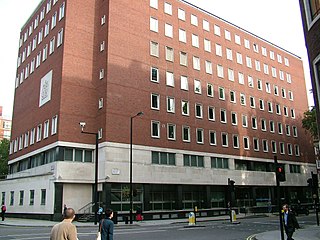
The City of Westminster Magistrates' Court was a magistrates' court located at 70 Horseferry Road, in the City of Westminster, London. It was originally called Horseferry Road Magistrates' Court, after the road in which it was sited. However, it was renamed in July 2006 following the closure of Bow Street Magistrates' Court. It served as the court where the Chief Magistrate of England and Wales sat, and all extradition and terrorism-related cases passed through the court. The court closed permanently on 22 September 2011, and was replaced on 27 September 2011 with Westminster Magistrates' Court, built on the site of Marylebone Magistrates' Court at 181 Marylebone Road.
The Supreme Court is the highest court in Israel. It has ultimate appellate jurisdiction over all other courts, and in some cases original jurisdiction.
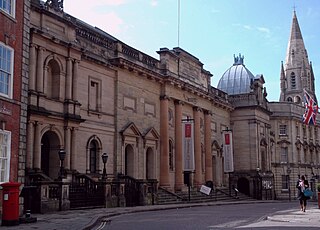
The National Justice Museum is an independent museum on High Pavement in the Lace Market area of Nottingham, England.
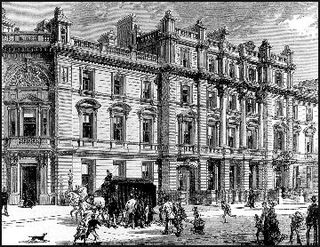
Bow Street Magistrates' Court became one of the most famous magistrates' court in England. Over its 266-year existence it occupied various buildings on Bow Street in Central London, immediately north-east of Covent Garden. It closed in 2006 and its work moved to a set of four magistrates' courts: Westminster, Camberwell Green, Highbury Corner and the City of London Magistrates' Court. The senior magistrate at Bow Street until 2000 was the Chief Metropolitan Stipendiary Magistrate.

The High Court of Kerala is the highest court in the Indian state of Kerala and the Union territory of Lakshadweep. It is located in Kochi. Drawing its powers under Article 226 of the Constitution of India, the High Court has the power to issue directions, orders and writs including the writs of habeas corpus, mandamus, prohibition, quo warranto and certiorari for ensuring the enforcement of the Fundamental Rights guaranteed by the Constitution to citizens or for other specified purposes. The High Court is empowered with original, appellate and revisional jurisdiction in civil as well as criminal matters, and the power to answer references to it under some statutes. The High Court has the superintendence and visitorial jurisdiction over all courts and tribunals of inferior jurisdiction covered under its territorial jurisdiction.

The judiciary of Gibraltar is a branch of the Government of Gibraltar that interprets and applies the law of Gibraltar, to ensure equal justice under law, and to provide a mechanism for dispute resolution. The legal system of Gibraltar is based on English law and is a mix of common law and statute. The hierarchical system of courts includes a magistrates' court, a supreme court and a non-resident appellate court.
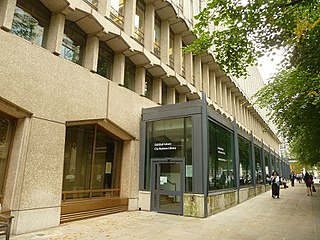
The Guildhall Library is a public reference library specialising in subjects relevant to London. It is administered by the Corporation of London, the government of the City of London, which is the historical heart of London, England.
The Commercial Court is a sub-division of the Queen's Bench Division of the High Court of Justice, the major civil court in England and Wales. It is based in the Rolls Building, the world's largest dedicated business dispute resolution centre.
Woolwich Crown Court, located at 2 Belmarsh Road, Thamesmead is one of twelve Crown Court centres serving Greater London.
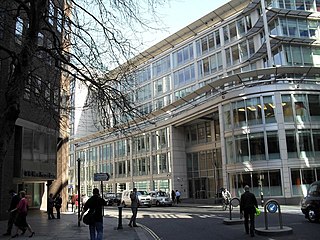
Fetter Lane is a street in the ward of Farringdon Without in the City of London. It forms part of the A4 road and runs between Fleet Street at its southern end and New Fetter Lane, which continues north towards Holborn Circus.

The Shire Hall in Agincourt Square, Monmouth, Wales, is a prominent Grade I listed building in the town centre. It was built in 1724, and was formerly the centre for the Assize Courts and Quarter Sessions for Monmouthshire. In 1839–40, the court was the location of the trial of the Chartist leader John Frost and others for high treason for their part in the Newport Rising. The building was also used as a market place. The Shire Hall is owned by Monmouthshire County Council and has audiovisual guides for visitors to Courtroom 1. It is currently used as a Tourist Information Centre and as the offices for Monmouth Town Council, and is open to the public in part.
The Technology and Construction Court is a sub-division of the Queen's Bench Division, part of the High Court of Justice, which together with the Crown Court and the Court of Appeal, is one of the Senior Courts of England and Wales. The Civil Procedure Rules, which regulate civil procedure in the High Court, allocate non-exhaustive categories of work to the court, principally, as the name suggests, disputes in the areas of construction and technology.

The Richard J. Hughes Justice Complex is located in Trenton, the capital of the State of New Jersey. It is home to the New Jersey Supreme Court and other judicial and executive departments. Named in honor of Richard J. Hughes, a former Governor and Chief Justice in New Jersey, it is one several judicial centers in the city.

The Middlesex Street Estate is a housing estate in the Portsoken ward on the east edge of the City of London. It was connected to other local buildings by an elevated walkway system called the City of London Pedway Scheme.

The High Court of Australia building is located on the shore of Lake Burley Griffin in Canberra's Parliamentary Triangle. It is currently the home to the High Court of Australia. The High Court building was designed between 1972 and 1974 by the Australian architect Christopher Kringas (1936–1975), a director of the firm Edwards Madigan Torzillo and Briggs. The building was constructed from 1975 to 1980. Its international architectural significance is recognised by the Union of International Architects register of 'Architectural Heritage of the 20th Century'. It received the Australian Institute of Architects 'Canberra Medallion' in 1980 and the award for 'Enduring Architecture' in 2007. The High Court building was added to the Commonwealth Heritage List in 2004.
















